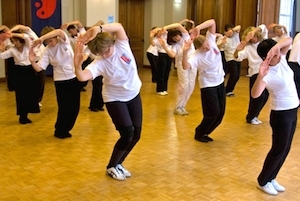Tai Chi Errors
When learning tai chi much time can be saved by having a clear sense of what is wrong, where the errors are, and taking the time to understand how best to correct them. It is, unfortunately, very common to see even long-term practitioners repeating the same mistakes over and over again. By trying to train with a real sense of objectivity and ‘listening’ energy you will be better placed to notice when things aren’t as they should be.

Here is a list of what we believe to be some of the most common errors. We would, of course, welcome the views of others on this matter.
1. Stance – Try to ensure your feet are shoulder-distance apart, narrow stances mean you have to compensate in other areas to maintain good balance.
2. Over-reaching – Try to resist the temptation to push out with your arms and upper body, consider moving in from the lower body rather than stretching out from the upper body.
3. Tension – Consider that the arms and hands are there for ‘listening’ and that by maintaining softness and relaxation the sensory aspects are hightened.
4. Posture – Think about keeping a straight line along the spine.
5. Weight Transferrence – Try to really experience every aspect of transferring your weight from one foot to the other by keeping a low centre of gravity when moving.
6. Upper Body Focus – Often when beginners are at the early learning stage they focus on the arms and upper body and, as such, their energy is focused in this area. Try to consider lightness in the upper body and a deep connection with the ground.
7. Direction – Take the time to familiarise yourself with the orientation of the various postures in your form. Being a little bit off in one move can gradually lead the practitoner to lose direction.
8. Lack of Focus – Once you are clear on the direction of the movements familiarise yourself with the purpose of each posture. This will lead you to having a greater focus during your practice.
9. Disconnection – The whole body should move as one unit, usually from the waist and/or pelvic area. Try to notice if your arms and hands are still moving after your your weight transferrence has stopped.
10. Continuity – Notice if you have a tendency to stop or slow down a little more at some movements, generally the form should be executed in a smooth, harmonious manner.
We welcome your views on what you feel to be common errors. Drop us an email or go to the contact link. Learn more about us.
Author: Taiji-Forum
Images: Taiji-Forum

